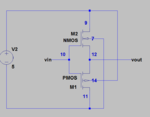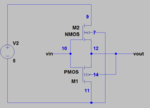luca89
Junior Member level 1
Hi everyone, I would like someone of you give a suggestion about the problem i have to build an electronic circuit.
(1)I want to build aPUSH-PULL amplifier (which is not THE LOGIC INVERTER but is an amplifier) made in CMOS by using the CD4007ub
(2)I made the following connection to try :

and it work. But the system start to heat up if i connect 14 (bulk of pmos) to the 12 (output) and Vin is 0V . Why?

I wanted to connect the 14 to 12 because i wanted to eliminate the bulk effect of the PMOS => VSB=0
Anyone know what happen? Thank you very much . Have a nice day
(1)I want to build aPUSH-PULL amplifier (which is not THE LOGIC INVERTER but is an amplifier) made in CMOS by using the CD4007ub
(2)I made the following connection to try :

and it work. But the system start to heat up if i connect 14 (bulk of pmos) to the 12 (output) and Vin is 0V . Why?

I wanted to connect the 14 to 12 because i wanted to eliminate the bulk effect of the PMOS => VSB=0
Anyone know what happen? Thank you very much . Have a nice day
